“Hello デス (desu)!”
The spry, playful greeting that Death Fes uses on its social media posts stands in stark contrast to the serious topic at hand. But that’s not where the playfulness ends.
Death Fes decks itself out in bright, neon colors for its logo and promotional material. At the event itself, some participants dressed up in colorful wigs and costumes and danced around the venue. One night, the awa-odori dance group Takarabune was on hand for a stirring “Matsuri + Death” performance.
 Death Fes 2025’s colorful banner belies its serious subject matter.
Death Fes 2025’s colorful banner belies its serious subject matter.
Japanese society has changed significantly in the past several decades. In 1950, the number of people age 65 and older in Japan was 4.9% of the total population. Today, it’s 29.1%. Many don’t leave children behind when they die, which complicates traditional customs such as caring for the family gravestone. Despite this, the way people in Japan approach death has remained largely unchanged over the last century.
Death Fes ran this year from April 12th to 17th. The date crossed over April 14th, which the group has christened “Good Death Day” (the numbers 4/14 can be pronounced yo-i-shi, よい死, or “good death”).
Under the slogan “Well-Being in Life and in Death” (生もしもウェルビーイング), the Death Fes organization has spent the past several years encouraging people to think differently about death in a country where the topic remains taboo. That includes exploring new forms of burial and turning funerals from a time of mourning someone’s death into a celebration of their life.
The event even gives you the chance to die.
“The fatality rate for life is 100%”
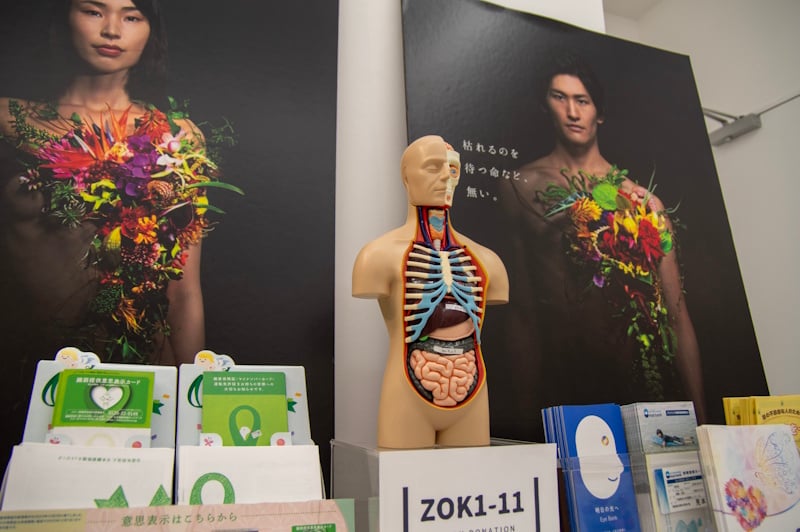 Picture: Albert Siegel / Unseen Japan
Picture: Albert Siegel / Unseen Japan
“We want to get everyone thinking about death,” event PR coordinator Sawa Mika told me while showing me around the exhibit hall for the small but meaningful event. “Whether they’re in their teens or their 90s.”
Death Fes aims to foster “a death-diverse society” within Japan. With Japan’s demographics changing quickly, event organizers feel, its attitudes towards and approaches to death need to broaden. That requires knocking down taboos and barriers around discussing death while we’re still living.
“There’s a lot of information in Japan about death,” said Ichikawa Nozomi, one of the event’s co-chairs. “But it’s incredibly difficult to discuss it in Japan as it pertains to one’s self. There’s a taboo about talking about one’s death or the death of family. If someone dies suddenly, then preparations for a funeral and the attending procedures come up fast. People find themselves regretting they hadn’t prepared themselves better.”
Better information about death to help the living
 In Japan, cremation is the rule in 99.97% of all deaths. Surgeons used to replace eyes in eye donors with plastic eyes that melted during cremation. These new style of replacement eyes burn up completely, leaving nothing noticeable behind in the ashes. (Picture: Albert Siegel / Unseen Japan)
In Japan, cremation is the rule in 99.97% of all deaths. Surgeons used to replace eyes in eye donors with plastic eyes that melted during cremation. These new style of replacement eyes burn up completely, leaving nothing noticeable behind in the ashes. (Picture: Albert Siegel / Unseen Japan)
Those barriers take many forms. One of them is the way that people in Japan think about organ donation.
In other countries, brain death is considered death. However, in Japan, that wasn’t legally solidified until 1997. Today, many people still believe someone is still alive if their heart is still beating, even if their brain has ceased to function.
This affects organ donation in Japan, as many people won’t agree to donate their organs until after their heart stops beating. By that time, organs such as the lungs, intestines, and liver are no longer viable. According to the Japanese Organ Transplant Network (JOT), this means that, while 16,000 people agree to donate organs after heart death, only 600 agree to donate after brain death.
 A picture from a JOT brochure indicating which organs people donate in Japan. The kidneys predominate, with far fewer agreeing to donate organs that are viable after brain death.
A picture from a JOT brochure indicating which organs people donate in Japan. The kidneys predominate, with far fewer agreeing to donate organs that are viable after brain death.
As a result, Japan faces a severe shortage of organs for use in life-saving transplants, leaving surgeons scrambling to obtain organs from abroad. JOT hopes that its participation in such events can raise awareness about the drastic need for in-country organ donation.
Faces of death help survivors cope
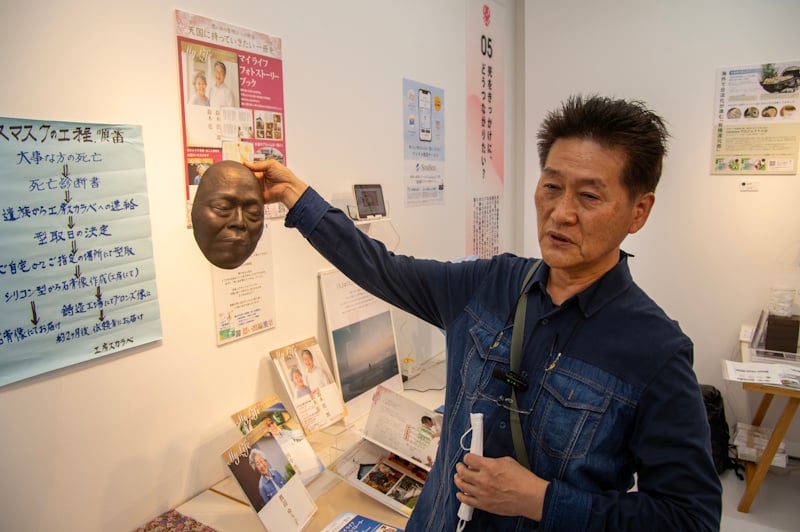 Artist Gondō Toshio shows the death masks he makes for surviving family members to memorialize their loved ones. (Picture: Albert Siegel / Unseen Japan)
Artist Gondō Toshio shows the death masks he makes for surviving family members to memorialize their loved ones. (Picture: Albert Siegel / Unseen Japan)
“When people open the box up, they almost cry. ‘Welcome back home,’ they’ll say. It’s very touching.”
Planning a trip to Japan? Get an authentic, interpreted experience from Unseen Japan Tours and see a side of the country others miss!

“Noah [at Unseen Japan] put together an itinerary that didn’t lock us in and we could travel at our own pace. In Tokyo, he guided us personally on a walking tour. Overall, he made our Japan trip an experience not to forget.” – Kate and Simon S., Australia

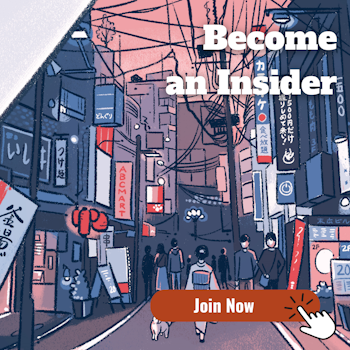
Want more news and views from Japan? Donate $5/month ($60 one-time donation) to the Unseen Japan Journalism Fund to join Unseen Japan Insider. You’ll get our Insider newsletter with more news and deep dives, a chance to get your burning Japan questions answered, and a voice in our future editorial direction.

Stay connected while in Japan with an eSim from our partners at Inbound Platform. Get fast and unlimited 5G data, access across 99% of the country, and excellent English language customer service. No chip to install – just download into your phone and use as soon as you land! (Affiliate link)

Get the white-glove treatment with a luxury ride from the airport – Haneda, Narita, or Osaka (KIX) – with Inbound Platform’s taxi service. Your driver will be waiting for you at the airport. If there are issues, you can depend on their highly-rated English language customer support. (Affiliate link)

Want to speak better Japanese before your trip to Japan? Or just for fun? Use Preply to connect with a native speaker and practice, no matter where you are in the world. Improve your Japanese while also making new friends and learning about Japanese culture and history. (Affiliate link)
Gondō Toshio holds up a mask of a 71-year-old woman, made three years before she died. He makes the masks from either gypsum and silicone or bronze, using real face casts that don’t leave any indelible marks on the skin. Gypsum masks run around 165,000 yen ($1,160), while bronze runs 364,000 yen ($2,550). Gondō also does hand casts.
Gondō is a sculptor in Chiba Prefecture who tried to find a way to deal with his grief after his parents passed away around a decade ago. Now his business, Scarab (スカラベ; sukarabe), focuses on creating death masks. Long a tradition around the world dating back thousands of years, the memorial devices have little purchase in Japan. “Only a few famous people, like [authors] Natsume Sōseki or Mori Ōgai,” he said.
The mask pictured above was made at the behest of the woman’s son. “I think they help accelerate the grieving process,” he said of his work.
Other booth attendees offered different ways of remembering and preserving your loved ones. One Swiss-based company, Algordanza, is trying to sell people on the idea of turning their dearly departed’s ashes into compressed diamonds. This approach leaves no grave or tomb to maintain – and means you can keep the people you hold dearest close to you.
 Picture: Albert Siegel / Unseen Japan
Picture: Albert Siegel / Unseen Japan
I died ( and lived to tell the tale)
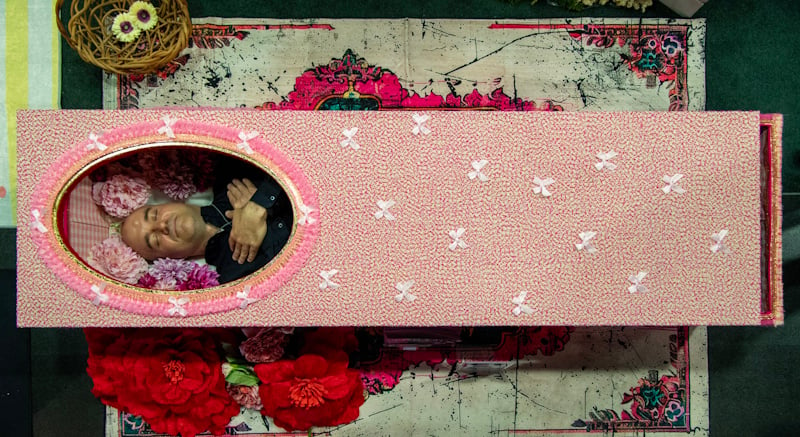 My funeral was very moving. (Picture: Albert Siegel / Unseen Japan)
My funeral was very moving. (Picture: Albert Siegel / Unseen Japan)
Death Fes also runs sessions from numerous speakers on a variety of topics. When we were attending, for example, the day’s opening lecture featured a talk from Professor Takatsume Ōsaburō on the relationship between death and religion.
Without question, however, the flagship exhibit at Death Fes comes courtesy of Fuse Mikako of the company Grave Tokyo.
Fuse, a native of Akita Prefecture, originally trained as a fashion designer, graduating from Tokyo’s renowned Bunka Fashion College. However, in her 20s, she suffered the deaths of numerous close friends. Most of them were artists.
“They were stylish,” she said. “They loved colorful things.” Yet, when she went to their funerals, “everything was sheer white. It didn’t befit them at all. I couldn’t help thinking, ‘they weren’t like this.’”
In response, Fuse started Grave Tokyo, which crafts caskets that are more befitting of the deceased than a plain white box. While she has a number of pre-designed caskets, most of them are order-made. Some are even decorated with the deceased’s favorite characters in life.
“When you see someone in their casket, that’s the last time you’ll see them, right?” she said. “I want to offer a service that makes people go, ‘Oh, those clothes are so stylish, they were just like this, the design of the casket captures them. It’s just like her or him.’”
Into the casket you go
In Morishita in Tokyo’s Koto City, Fuse offers a “Coffin Experience” via snack bar Memento Mori. “No Karaoke, Just Coffins,” the site amusingly boasts in English. “A third place where we can talk openly about the end of life.” Run by Fuse and YOMI International CEO Murata Masumi, the location provides booze, an opportunity for cultural exchange, and, of course, their popular Coffin Experience Workshop.
Fuse brought the Coffin Experience to Death Fes, where I experienced it first-hand. After lying down in the coffin, she slowly ringed my head with flowers while offering touching words on my passing. “It was pretty tough, wasn’t it?” I felt a strange, unsettling hollowness open up in the pit of my stomach as it sank in that I was listening to my eulogy.
 Cause of death: Too much Famichiki, probably. (Picture: Albert Siegel / Unseen Japan)
Cause of death: Too much Famichiki, probably. (Picture: Albert Siegel / Unseen Japan)
After commemorating my passing, Fuse and an assistant sealed me in the coffin for three minutes. At first, my mind went racing, as it usually does when human beings are faced with silence for more than five seconds. Eventually, I remembered, “Oh, wait – I’m dead.” I fell back on Buddhist meditation techniques I’ve practiced on and off for years to let those thoughts go and the feelings sink in.
I’d like to say I had a changed view of life and death upon emerging from my temporary tomb. Sadly, the deepest thought I came away with is that it’d be pretty cool to go out in a pink coffin.
Planning a trip to Japan? Get an authentic, interpreted experience from Unseen Japan Tours and see a side of the country others miss!

“Noah [at Unseen Japan] put together an itinerary that didn’t lock us in and we could travel at our own pace. In Tokyo, he guided us personally on a walking tour. Overall, he made our Japan trip an experience not to forget.” – Kate and Simon S., Australia


Want more news and views from Japan? Donate $5/month ($60 one-time donation) to the Unseen Japan Journalism Fund to join Unseen Japan Insider. You’ll get our Insider newsletter with more news and deep dives, a chance to get your burning Japan questions answered, and a voice in our future editorial direction.

Stay connected while in Japan with an eSim from our partners at Inbound Platform. Get fast and unlimited 5G data, access across 99% of the country, and excellent English language customer service. No chip to install – just download into your phone and use as soon as you land! (Affiliate link)

Get the white-glove treatment with a luxury ride from the airport – Haneda, Narita, or Osaka (KIX) – with Inbound Platform’s taxi service. Your driver will be waiting for you at the airport. If there are issues, you can depend on their highly-rated English language customer support. (Affiliate link)

Want to speak better Japanese before your trip to Japan? Or just for fun? Use Preply to connect with a native speaker and practice, no matter where you are in the world. Improve your Japanese while also making new friends and learning about Japanese culture and history. (Affiliate link)
Grave Tokyo wasn’t the only experiential aspect of Death Fes. The event also featured Jigoku VR (地獄VR), a virtual reality experience created by a Buddhist temple in Yokohama, which provides a firsthand experience of the Buddhist conception of Hell.
Freedom in facing death
 Picture: Albert Siegel / Unseen Japan
Picture: Albert Siegel / Unseen Japan
Other booths sold a variety of accessories that the deceased can use to go out in style. Designer Vivienne Satō, for example, was selling flowery headdresses in a vast array of colors.
“Wearing makeup and a headdress isn’t about becoming someone else or making an unusual transformation,” Satō wrote on their Instagram in relation to the event. “Makeup and dress-up are acts that gradually strip you naked and return you to your true self.”
I also spoke with Nene, part of a mother/daughter that runs Sewing Cafe Nico. That cafe led the two into creating “ending dresses” and veils.
“We started exhibiting here last year,” she said. “We got a lot of consultations and orders, which showed us there was a demand for what we were selling.”
The key question is whether the event is changing people’s minds about death. PR coordinator Sawa seems to think so. Last year’s event saw over 2,000 participants. They expect to exceed that this year.
Grave Tokyo’s Fuse said that, while Japan has many fixed ideas about death, she also sees an opportunity for change.
“Japanese people aren’t very religious. Most people in Japan first encounter religion when their parents die.” (Most funeral ceremonies in Japan are Buddhist in nature.) “I think that, precisely because religion doesn’t have strong roots here, there are multiple ways one can approach death. There’s freedom.”
Death Fes will run again around the same time next year in 2026. Many participants speak English, and foreign visitors are welcome.
Visitors interested in the Casket Experience can visit Snack Bar Memento Mori, which is also welcoming to foreign visitors and English speakers. (Plus, they have booze, which always makes social interactions easier.) Memento Mori runs from 6pm to 11pm every evening except Sundays and holidays.
Sources
高齢化の状況. Cabinet Office of Japan
なぜここまで広がった? 世界一の「火葬大国」ニッポン 時代とともに担い手にも変化. Asahi Globe
Death mask. Wikipedia
昨年2,000人が訪れた「Deathフェス」渋谷ヒカリエで規模拡大開催. Death Fes Corporation (via PRTimes)

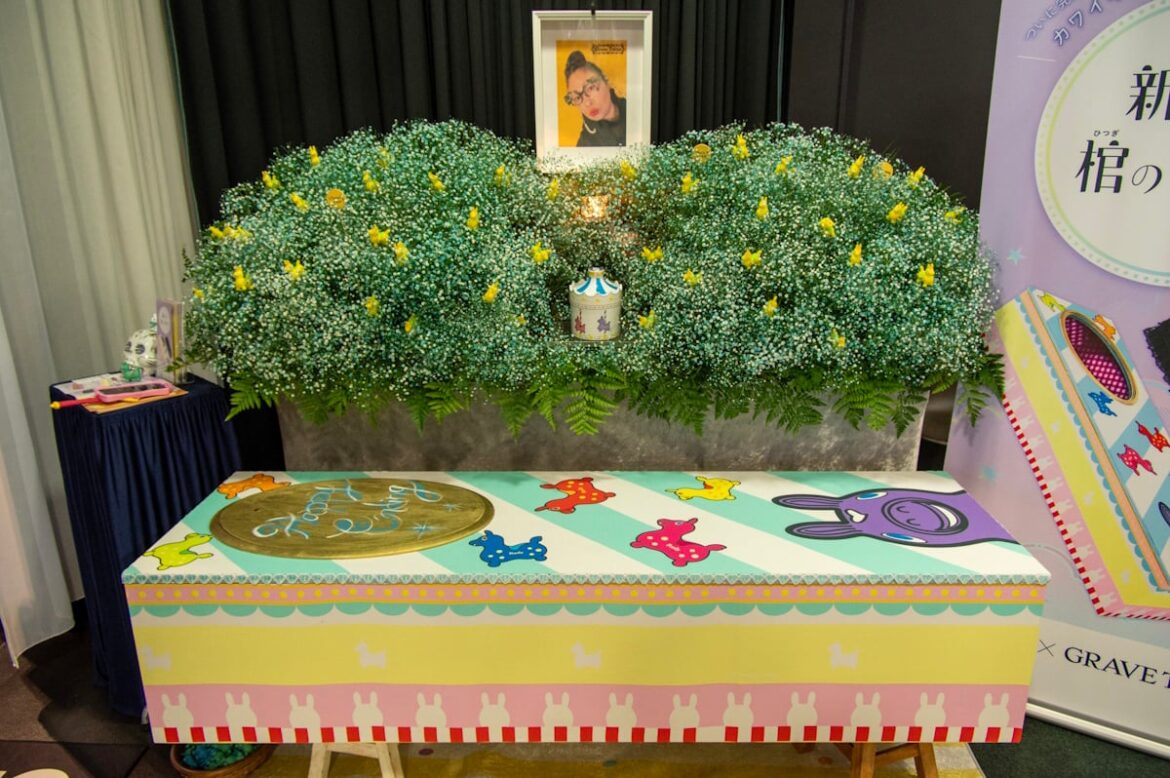
AloJapan.com